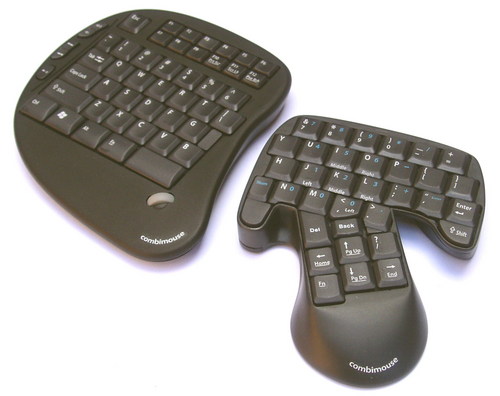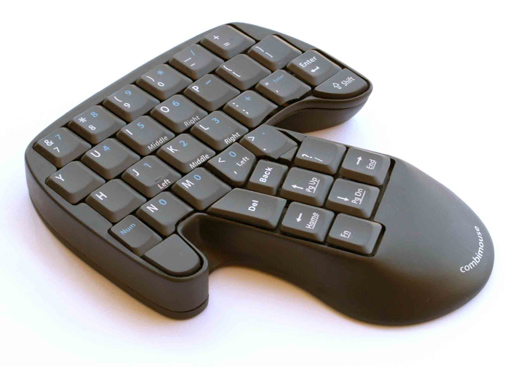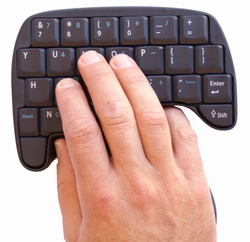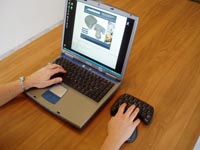Combimouse, a hybrid mouse and keyboard, launched a crowdsourcing campaign
Dear Habra users, please do not minus the article and me only because you do not like the idea of this project. Believe me, there are enough people to whom this device will be useful so that it has the right to life. Do not deprive them of the Russian-language part of the opportunity to learn about him and do not punish me for wanting to tell about him.
 Combimouse - a hybrid of a mouse and keyboard for those who own a ten-finger set .
Combimouse - a hybrid of a mouse and keyboard for those who own a ten-finger set .
The goal of the project is to save the user from the need to constantly shift the right hand from the mouse to the keyboard and vice versa.
This need always bothered me. I have repeatedly tried to minimize the need for a mouse: I tried to use the hot keys to the maximum, in Opera I used spatial navigation (Shift + arrows), I mastered Vim, the mode of which is in any decent IDE and even in Chrome . There is a TrackPoint on the laptop , but the accuracy and speed of cursor positioning with it (and especially with the touchpad) is much lower than with a mouse.
All this reduces the need for constant hand movement, but does not eliminate it. A mouse on a modern PC is always needed, on any OS and with any kind of activity.
Australian Ari Zagnoev proposes to solve this problem radically: integrate the right half of the keyboard directly into the mouse. I followed this project for many years. For a long time, it existed in the form of a concept and a single prototype. Finally, the author pushed things off and started crowdfunding.
 Combimouse consists of two halves. The left is stationary and is just half the usual keyboard. Right - mouse with integrated right half of the keyboard. Further we will focus only on her.
Combimouse consists of two halves. The left is stationary and is just half the usual keyboard. Right - mouse with integrated right half of the keyboard. Further we will focus only on her.
On the right side of the mouse is a sensor that responds to touching the little finger. When you hold Combimouse with your fingers from the sides, it works in mouse mode. When you transfer your fingers to the keys - switches to keyboard mode.
In mouse mode, you can use either of the two key pairs as the right and left keys: [,] and [L] or [J] and [O], depending on how you are used to holding the mouse. If your palm rests on the table all the time, and you hold the mouse with your fingertips (“fingertip grip” or “claw grip”), the pair of keys below will suit you. If you are used to putting the whole palm on the mouse, then you will prefer a couple of keys above.
In keyboard mode, Combimouse is immobilized. How exactly this will be implemented is kept secret until a patent is received for the technology.


Authors plan to implement scrolling instead of a mouse wheel using a tactile sensor on one of the keys.
The authors of the project assure that, despite the massive appearance, Combimouse will weigh no more than a wireless gaming mouse. The center of gravity will also be located similarly to a traditional mouse, apparently due to the location of the battery in the back.
The authors expect to put the price of the device at $ 150.
Specifications Combimouse listed on the official website , however, most likely, are not final.
According to the authors of the project, Combimouse has the following advantages:
The authors honestly warn that the device will have the following disadvantages:
Crowdfunding aims to raise funds for the initial development of the project. Unfortunately, we are not talking about mass production yet.
The choice of IndieGoGo as a fundraising platform, I suppose, is due to the fact that there the author of the project receives all donations, even if the declared amount is not collected. On Kickstarter, the author receives all or nothing.
With the raised funds, a new prototype (two pieces) will be manufactured that meets the requirements of mass production. This includes the design of cases, boards, membrane plates, and keys. A lawyer will be hired to prepare and file a patent. New prototype tests will be conducted, this time at Australian Curtin University, to identify all ergonomic “roughnesses.” Engineers in Australia will be hired and a manufacturer selected in China.
If there is enough money, production will follow, which will require another six months. If there is not enough money, the authors will look for investors.
For $ 110, backers will receive Combimouse from the first limited batch. You can pay more: the more you pay, the closer you will be to the beginning of the line. Payment from $ 200 also includes free international shipping.
If you donate a smaller amount, this will give you a discount on the subsequent acquisition of Combimouse. The discount exceeds the donated amount.
I understand that this project in the eyes of, probably, most of you looks ridiculous. A wave of monotonous jokes is simply inevitable.
But personally, I really hope that the authors will be able to launch mass production. Computer ergonomics is in deep stagnation: nothing has changed in it, absolutely nothing since the invention of the ball mouse in the early seventies.
I repeat that Combimouse is a niche product that is not aimed at a wide audience, but only at some of the people who own blind set. In the comments on the article on blind typing(which, coincidentally, was published on the day the Combimouse crowdfunding began) a couple of people spoke out about the inconvenience of constantly shifting hands between the mouse and keyboard. So if you do not need a subject personally, this does not mean that no one needs it. I need it. At least I and that guy over there. Probably ... :)
The fact that the Combimouse project has moved off the ground, I learned exactly at the moment when I was thinking about buying an Ergotron bracket. I dreamed that I could work with the computer not only sitting at the table, but also lying on the sofa next to it - the bracket would allow the monitor to be deployed to the sofa without the slightest effort. So, I found that holding the keyboard on the belly is very inconvenient. It would be more convenient to hold the keyboard halves on the sides near the hips and type with relaxed, straightened hands.
A thorough review of the market showed that no manufacturer in the world produces keyboards consisting of two wireless halves. And here is such a gift - wireless halves, and even integration with the mouse. I donated $ 110 without hesitation.
Of course, there is a chance that I won’t get my Combimouse at all. There is a chance that the first batch will be unsuccessful. I already had a bad experience with Warmouse Meta. There, the authors released the product at their own expense, but at a very high cost. In addition to the controversial ergonomics, the software (with closed source code) had a couple of heavy bugs that made the device useless. The authors released updates, but at some point they simply disappeared. Stopped responding to letters, blogging and twittering, releasing software. It is possible that Combimouse will face the same fate.
But I am optimistic. The author of the project has a very thorough approach.
In general, if you are the same ten-finger freak like me, join us .
PS The author of the project on IndieGoGo very responsively answers questions and accepts wishes. So, he promised to make the keys fully configurable, which will allow everyone to customize Combimouse in accordance with their needs.
 Combimouse - a hybrid of a mouse and keyboard for those who own a ten-finger set .
Combimouse - a hybrid of a mouse and keyboard for those who own a ten-finger set . The goal of the project is to save the user from the need to constantly shift the right hand from the mouse to the keyboard and vice versa.
This need always bothered me. I have repeatedly tried to minimize the need for a mouse: I tried to use the hot keys to the maximum, in Opera I used spatial navigation (Shift + arrows), I mastered Vim, the mode of which is in any decent IDE and even in Chrome . There is a TrackPoint on the laptop , but the accuracy and speed of cursor positioning with it (and especially with the touchpad) is much lower than with a mouse.
All this reduces the need for constant hand movement, but does not eliminate it. A mouse on a modern PC is always needed, on any OS and with any kind of activity.
Australian Ari Zagnoev proposes to solve this problem radically: integrate the right half of the keyboard directly into the mouse. I followed this project for many years. For a long time, it existed in the form of a concept and a single prototype. Finally, the author pushed things off and started crowdfunding.
Technical details
 Combimouse consists of two halves. The left is stationary and is just half the usual keyboard. Right - mouse with integrated right half of the keyboard. Further we will focus only on her.
Combimouse consists of two halves. The left is stationary and is just half the usual keyboard. Right - mouse with integrated right half of the keyboard. Further we will focus only on her. On the right side of the mouse is a sensor that responds to touching the little finger. When you hold Combimouse with your fingers from the sides, it works in mouse mode. When you transfer your fingers to the keys - switches to keyboard mode.
In mouse mode, you can use either of the two key pairs as the right and left keys: [,] and [L] or [J] and [O], depending on how you are used to holding the mouse. If your palm rests on the table all the time, and you hold the mouse with your fingertips (“fingertip grip” or “claw grip”), the pair of keys below will suit you. If you are used to putting the whole palm on the mouse, then you will prefer a couple of keys above.
In keyboard mode, Combimouse is immobilized. How exactly this will be implemented is kept secret until a patent is received for the technology.


Authors plan to implement scrolling instead of a mouse wheel using a tactile sensor on one of the keys.
The authors of the project assure that, despite the massive appearance, Combimouse will weigh no more than a wireless gaming mouse. The center of gravity will also be located similarly to a traditional mouse, apparently due to the location of the battery in the back.
The authors expect to put the price of the device at $ 150.
Specifications Combimouse listed on the official website , however, most likely, are not final.
Advantages and disadvantages
According to the authors of the project, Combimouse has the following advantages:
- Combimouse provides instant transition between mouse and keyboard without any effort. It is extremely convenient to use. Combimouse is arguably the fastest and most efficient data entry method that requires frequent mouse use. Often people avoid using the mouse because of the unpleasant need to take their hands off the keyboard all the time (I’ll add that no fewer people almost never use the keyboard for the same reason).
- The right half has a built-in digital unit, making Combimouse an excellent tool for navigating spreadsheets and entering data into them.
- Combimouse includes a multi-button mouse that is convenient for games (primarily, apparently, for MMORPG, but the authors assure that Combimouse also performs well in FPS), CAD design, and most other applications.
- The authors of the project received many emails from people with various disabilities. These people write how Combimouse will help them cope with their limitations.
 When using a traditional keyboard, the mouse is located to the right of it. Combimouse eliminates the need to take your right hand too far.
When using a traditional keyboard, the mouse is located to the right of it. Combimouse eliminates the need to take your right hand too far.- Combimouse saves desk space. The halves of the device are small enough to push them away when they are not needed. During use, they can be kept both in front of you and on either side of yourself, making room in front of you for papers (or plates of dumplings!).
- The right half of the device can be used with a laptop, which provides the laptop with both a mouse, an instantly accessible keyboard and a block of numeric keys.
The authors honestly warn that the device will have the following disadvantages:
- Only suitable for people with blind typing.
- Only suitable for righties.
- The price of the device will match the high-end sets of wireless peripherals. The authors will try to meet $ 150.
- The mouse is low. If you put the entire palm on the mouse (“palm grip”), the mouse does not completely fill it (like the Apple Magic Mouse).
- To ensure an acceptable weight, the right half will be less durable than other mice. Probably, she can not withstand falling to the floor from the height of the table.
- The digital block is combined with the keys of the right half of the keyboard, similar to how it is done in laptops.
- Many additional keys are moved compared to their location on a traditional keyboard.
- Home, End, Page Up and Page Down are implemented through the Fn modifier key.
- Backspace and Delete are moved from their usual places, however they are located very conveniently.
Project stages
- 1999 - Australian Ari Zagnoev invented and patented Combimouse
- 2003 - A prototype device was tested by Wichita State University (Kansas, USA). The report is available here . Tests have shown that Combimouse is not inferior to the mouse in terms of work efficiency. The typing speed on Combimouse turned out to be lower than on a traditional keyboard. Researchers note that this is definitely due to the lack of subjects' habits for an unusual device.
- 2003 - Australian Minister of Information Technology presents Ari with an Australian IT Secrets award.
- 2003—2013 - ???
- March 2013 - the second prototype was manufactured. This is a technical prototype, roughly executed externally, so the first prototype appears on all the photos.
- April 2013 - IndieGoGo launched a campaign to raise funds for the development of the project.
Fundraising
Crowdfunding aims to raise funds for the initial development of the project. Unfortunately, we are not talking about mass production yet.
The choice of IndieGoGo as a fundraising platform, I suppose, is due to the fact that there the author of the project receives all donations, even if the declared amount is not collected. On Kickstarter, the author receives all or nothing.
With the raised funds, a new prototype (two pieces) will be manufactured that meets the requirements of mass production. This includes the design of cases, boards, membrane plates, and keys. A lawyer will be hired to prepare and file a patent. New prototype tests will be conducted, this time at Australian Curtin University, to identify all ergonomic “roughnesses.” Engineers in Australia will be hired and a manufacturer selected in China.
If there is enough money, production will follow, which will require another six months. If there is not enough money, the authors will look for investors.
For $ 110, backers will receive Combimouse from the first limited batch. You can pay more: the more you pay, the closer you will be to the beginning of the line. Payment from $ 200 also includes free international shipping.
If you donate a smaller amount, this will give you a discount on the subsequent acquisition of Combimouse. The discount exceeds the donated amount.
Personal opinion
I understand that this project in the eyes of, probably, most of you looks ridiculous. A wave of monotonous jokes is simply inevitable.
But personally, I really hope that the authors will be able to launch mass production. Computer ergonomics is in deep stagnation: nothing has changed in it, absolutely nothing since the invention of the ball mouse in the early seventies.
I repeat that Combimouse is a niche product that is not aimed at a wide audience, but only at some of the people who own blind set. In the comments on the article on blind typing(which, coincidentally, was published on the day the Combimouse crowdfunding began) a couple of people spoke out about the inconvenience of constantly shifting hands between the mouse and keyboard. So if you do not need a subject personally, this does not mean that no one needs it. I need it. At least I and that guy over there. Probably ... :)
The fact that the Combimouse project has moved off the ground, I learned exactly at the moment when I was thinking about buying an Ergotron bracket. I dreamed that I could work with the computer not only sitting at the table, but also lying on the sofa next to it - the bracket would allow the monitor to be deployed to the sofa without the slightest effort. So, I found that holding the keyboard on the belly is very inconvenient. It would be more convenient to hold the keyboard halves on the sides near the hips and type with relaxed, straightened hands.
A thorough review of the market showed that no manufacturer in the world produces keyboards consisting of two wireless halves. And here is such a gift - wireless halves, and even integration with the mouse. I donated $ 110 without hesitation.
Of course, there is a chance that I won’t get my Combimouse at all. There is a chance that the first batch will be unsuccessful. I already had a bad experience with Warmouse Meta. There, the authors released the product at their own expense, but at a very high cost. In addition to the controversial ergonomics, the software (with closed source code) had a couple of heavy bugs that made the device useless. The authors released updates, but at some point they simply disappeared. Stopped responding to letters, blogging and twittering, releasing software. It is possible that Combimouse will face the same fate.
But I am optimistic. The author of the project has a very thorough approach.
In general, if you are the same ten-finger freak like me, join us .
PS The author of the project on IndieGoGo very responsively answers questions and accepts wishes. So, he promised to make the keys fully configurable, which will allow everyone to customize Combimouse in accordance with their needs.
